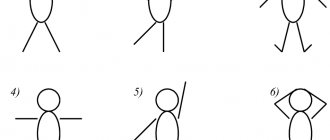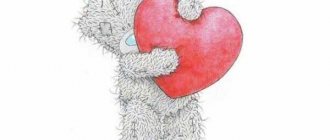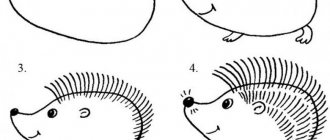Summary of a drawing lesson in the junior group “Beautiful Clothes”
Marina Fursova
Summary of a drawing lesson in the junior group “Beautiful Clothes”
Teach children to decorate a dress.
— Continue to teach children how to hold a colored pencil correctly.
— Develop fine and gross motor skills.
— Develop visual attention, the ability to visually coordinate your movements.
- Continue learning to differentiate primary colors.
— Cultivate attention, goodwill, and a sense of mutual assistance.
— Didactic game “Pick a dress for the doll”
,
— Conversation on the topic: “What kind of clothes ”
.
- Looking at illustrations depicting different dresses.
— Drawing geometric shapes using stencils.
Equipment and materials:
- treat: “Mushroom”
;
— paper dolls according to the number of children;
— silhouettes of dresses according to the number of children;
- samples of silhouettes of dresses with painted rings : red - blue ; yellow – green; red – yellow ; blue – yellow);
Progress of the lesson:
Kids are playing. Suddenly, crying is heard outside the door.
Educator: What's that noise? Who's that crying outside the door? I'll go and have a look. (Introduces a large doll into the group , which carries paper dolls in the car (according to the number of children)
Educator: Hello. What is your name?
Doll: Hello. I'm Katya.
Educator: Why are you crying, Katya?
Doll: The squirrel invited me to the squirrels’ birthday party. I wanted to give them dolls in beautiful outfits , but I didn’t have time to decorate all the dresses (The teacher takes silhouettes of dresses from her bag and shows them to the children)
.
(The doll is crying)
.
Educator: Don’t cry, now our children will help you. (Puts the doll on a chair)
.
Guys, what can we do to help?
Children: decorate dresses .
Educator: How smart you are. Come on guys, before we start our work, you and I will warm up.
(The teacher pronounces the text and performs the movements, and the children imitate him, finishing words and phrases)
There is a Katya doll in the closet. Stand up, move your hands from above
Sweatshirts, sundresses, dresses along the body.
There is a coat, two pairs of trousers, leaning forward, movements with palms
Bloomers for walking. along the legs from top to bottom.
Lots of blouses exactly, hardly Stand up, hands forward,
They hang in Katya's closet. alternate movement up and down.
Put these things on, Sit down, spread your arms to the sides.
And they call it clothes . Stand up, put your hands down.
Educator: What a great fellow you are, you have warmed up well, now let’s go back to our desks and start working.
Educator: I will now give you dresses and dolls. We will decorate the dress with colored pencils. Look how I decorated the dresses (sample display)
.
What did I draw on the dress ?
Educator: Yes. I drew rings on the sleeves , on top, in the middle, and at the bottom of the dress. I decorated the entire dress.
What color are the rings? (Points to the silhouettes of dresses with rings: red - blue ; yellow - green; red - yellow ; blue - yellow)
Children: Red , blue, yellow, green.
Educator: How will you draw ?
Children: Colored pencils
Educator: Now take a pencil in your hand and draw rings in the air. Practice. To make the dress beautiful and the rings to be visible, you need to press well on the pencil. Now choose what color your rings will be and start decorating your dresses. The dolls will watch you draw (if necessary, the teacher approaches the children and helps)
.
After finishing the drawing, the doll praises the children .
Educator: Take the dolls that are lying on your tables and put dresses on them.
Educator: Well done, children. Katya thanks you. She really liked the dresses. They became beautiful and elegant . What did you draw on the dresses ? (rings)
.
What colour? (
red , blue, yellow, green) . Do you think the baby squirrels will be happy with such a gift? Did you like decorating dresses yourself?
Let's put your dolls in the car (children come up to the car and put the dolls)
.
Educator: And as a farewell, doll Katya wants to treat you with gifts (takes out “Mushroom”
, treats children).
The doll says goodbye, leaves the group , driving the car.
Abstract of the OD “Winter Clothes and Shoes” on familiarization with the outside world in the first junior group “Winter Clothes and Shoes”. OD summary for familiarization with the outside world in the first junior group Goal: To promote the ability to classify.
GCD summary for the application “Beautiful Napkin” in the second junior group. GCD summary for artistic and aesthetic development (applique) “Beautiful Napkin” in the second junior group. Completed by Kosova L. E.
Abstract of the educational method for modeling in the junior group “Beautiful bird based on the Dymkovo toy” April. 1 week Notes on sculpting in the junior group “Beautiful Bird” (Based on the Dymkovo toy) Program content: learn to sculpt an object. Summary of GCD in the second junior group on the topic “Clothing”. LESSON SUMMARY on applique using ready-made forms (stickers) and drawing elements “Beautiful tablecloth” in the junior group LESSON SUMMARY ON APPLIQUE USING READY-made FORMS (STICKERS) AND DRAWING ELEMENTS “BEAUTIFUL TABLECLOTH” IN YOUNGER GROUP OBJECTIVES. Summary of the drawing lesson “Snowy Street” in the junior group Topic: “Snowy Street” Educational areas: cognitive, artistic-aesthetic, speech. Objectives: introduce the poem. Summary of a drawing lesson “Pattern on a mitten” in the junior group Topic: “Pattern on a mitten” Educational areas: cognitive, artistic and aesthetic, speech. Objectives: to introduce this work;.
Source
Summary of a drawing lesson in the first junior group “Let's decorate the dress”
Natalia Pavlova
Summary of a drawing lesson in the first junior group “Let's decorate the dress”
The main educational activity on the public educational institution “Artistic and aesthetic development”
(
drawing ) in the 1st
junior group No. 2 “
Let’s decorate the dress ” Natalya Aleksandrovna Pavlova, teacher of the MADOU
“Kindergarten No. 4”
Program content Educational: - teach
drawing patterns in an unconventional way (using cotton swabs )
;
- learn to make a pattern according to a diagram; - continue to consolidate the knowledge of the studied colors. Developmental: - continue to develop fine motor skills of the hands; imagination. Educational: - cultivate attentiveness, accuracy, polite treatment; - cultivate responsiveness. Equipment: doll, pattern diagram, circles of different colors, gouache, cut out dress .
Progress of educational activities (In the group there is a doll sitting on a chair.)
V. - Guys, who came to visit us?
D. - doll V. - Let's say hello to her and get to know her. How will we greet the doll?
D. - Hello, hello!
V. – Of course, you can greet a doll like that. And I’ll shake hands with the doll. (The children and the teacher greet the doll.)
V. – Guys, do we know her name?
D. – no
V. – Let’s ask the doll what’s her name?
D - What is your name?
Q – my name is Masha. B - So we met. Guys, today is a big holiday - the birthday of our city Pechora. Masha came to us for help. Masha is getting ready for the holiday, but she doesn’t have a beautiful dress . Q - What to do? How to help? D - buy a dress in a store , sew it, draw it . Q - Guys, look, Masha has a dress , is it beautiful? - Why isn’t it beautiful? D - It has beautiful patterns, flowers, etc. V. - What needs to be done to make the dress beautiful ?
D. – we need to decorate . B - That's right, it needs to be decorated . Let's decorate Masha's dress with the beautiful Komi patterns that we looked at today, and I will help you with this. Look, I have prepared dresses and they already have a Komi pattern, but it is pale and not beautiful, we will outline it with the help of these magic wands. (on the table are prepared cut out dresses with Komi patterns , paints and cotton swabs).
B - Let us, before we start, warm up a little (physical education)
)
Q - Well done guys, and now I suggest you take your seats and let’s start drawing a dress for our Mashenka . Now let's decorate Masha's doll's dress . (Joint drawing with children0 .
Q - Guys, what beautiful patterns you make, multi-colored (the teacher asks each child what color the patterns on their dress ). Masha, did you like how we decorated your dress ? Guys, did you like the patterns on the dress of the Masha doll ?
At the end of the lesson, the doll Masha “thanks”
each child and
“goes away”
for the holiday.
(An exhibition of works is being organized.)
Drawing lesson in the first junior group Topic: “Let’s decorate the tumbler”
Municipal preschool educational budgetary institution
"Kindergarten No. 4 of a combined type" Volkhov
Drawing class
in the first junior group
Topic: “Let’s decorate the tumbler”
Educator:
Ryabova I. Yu
Goal: to form in children an idea of the tumbler toy.
Tasks:
- teach children to decorate the silhouette of a tumbler with rhythmic strokes;
- arouse interest in reviving the applique image, in the search for visual and expressive means;
- cultivate a sense of color and shape.
Preliminary work:
Looking at tumblers of different sizes.
Clarification of the understanding of the meaning of the word “tumbler - a doll that does not fall, does not roll, does not lie down.”
Examination of the shape of a tumbler toy.
Modeling tumblers on the street from snow.
Comparison of tumblers with matryoshka.
Materials:
Sheets of white paper with silhouettes of tumblers pasted on by children, cotton swabs, brushes, paper and cloth napkins, paints, jars of water.
Progress lesson
We look at the tumbler and read an excerpt of the text of a Norwegian song:
- Dance, my doll
Dance more fun
Dance more fun
Don't be sorry for your heels.
- Guys, who is this?
Children's answers tumbler
- That's right guys! Why is she called that? (she doesn’t lie down, doesn’t roll around, but gets back up).
- The tumbler's body is round and its head is round. What shape is the body, what shape is the head?
Children's answers: round
- Guys, look at your tumblers. What do they lack?
Children's answers
- That's right, guys, they don't have any eyes, nose, or mouth. Let's draw the tumbler's face.
Children's answers
To do this, we will take a cotton swab, dip it in black paint and apply it to the face. It turned out to be an eye and another one. Then turn the stick with the other end and dip it in red paint. Let's draw a mouth.
Children draw
- These are the funny tumblers we got.
While the tumbler's face is drying up, a didactic game: “decorate the tumbler's dress.”
A tumbler is laid out on a flannelgraph; we invite children to decorate her dress with white peas.
- Now look, guys, our tumbler turned out to be ugly, let’s decorate her dress.
We take a brush, dip it in white paint and apply the entire pile to the dress. You can also decorate the dress with short lines, they can be arranged from top to bottom, or from left to right (teacher demonstration). To make peas, you need to dip the brush in the paint, apply the tip of the brush to the dress and remove it. These are the tumblers I got. After work, they form a round dance, and at this time we dance the dance: “We are cuties, tumbler dolls.” After the dance we look at our drawings.





